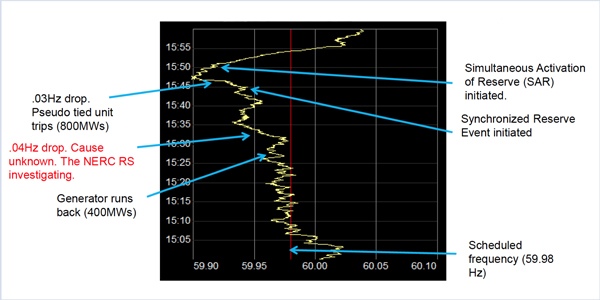VALLEY FORGE, Pa. — PJM is hoping to simplify its communication of items that require stakeholder action through a new “stakeholder impact slide” in appropriate presentations, PJM’s Rebecca Carroll told members at last week’s Operating Committee meeting.
The slide will identify what action is needed, the deadline and which stakeholders it impacts.
“It will spell out very clearly what the action is that is required for the stakeholder,” Carroll said.
The concept will be piloted in the OC and the Tech Change Forum before it’s rolled out elsewhere, she said.
Low Frequency
Grid operators handled an unusual number and variety of issues in July, staff explained.
Chief among them was a low-frequency event on July 10 between 3 and 4 p.m. Operators had been targeting a frequency of 59.98 Hz to account for a “time error correction,” but it fell to 59.903 Hz by 3:45 p.m. The event occurred in two frequency drops, and staff are puzzled over what caused the first one.
In the five minutes after 3:30 p.m., the frequency gradually dropped by 0.04 Hz, and PJM staff are working with NERC’s Resource Subcommittee to determine why. PJM’s Chris Pilong said the analysis is “not to point fingers” and that RTO tools intended to determine the cause of such issues “right now … aren’t pointing to anything.”
“It’s going to be outside the PJM system,” he said. “We’re thinking there may be some data errors in there somewhere.”
A second 0.03-Hz drop that began around 3:40 p.m. was caused by an 800-MW pseudo-tied unit tripping, Pilong said. Just before the drop, PJM initiated a synchronized reserve event, which deployed all the RTO’s synchronized reserves. PJM’s pseudo-tie error was roughly 900 MW under its target leading into the reserve event, and it dropped further down to 1,800 MW at the frequency’s lowest point.
PJM called a “simultaneous activation of reserve” (SAR) with the Northeast Power Coordinating Council at 3:50 p.m., about five minutes after the second frequency drop. The frequency rebounded to above its target level within five minutes.
Staff said the event isn’t normal but does happen every three years in the Eastern Interconnection. While this was the lowest they’d seen, it would have had to fall another 0.1 Hz for operators to call for a load action.
The puzzle for staff is what caused the initial drop, which drifted down rather than dropping immediately in a way indicative of a unit tripping.
“We drifted low. It wasn’t a step function low,” PJM’s Glen Boyle said.
Spinning Events
Grid operators also dealt with “obviously a higher volume of spinning events” than usual during July, Pilong said. The cause was multiple generators tripping, he said, but initial analysis indicates they were all unrelated. He said staff would analyze whether the system is experiencing more generators tripping or if there are any other takeaways.
“This could have just been a fluke month, or it could be a trend of something more,” Pilong said.
Load Shed
Staff confirmed that the load shed ordered July 18 was dissimilar to the load shed that occurred just months earlier in the same transmission zone.
The July 18 event occurred in the Lonesome Pine area on the border of Virginia and West Virginia after tripped equipment caused low voltage in the area. The events in American Electric Power’s zone were the first since PJM implemented Capacity Performance and its financial penalties and bonuses for generator performance during reliability events such as load sheds, though neither event triggered those calculations. (See 2nd Load Shed of PJM’s CP Era Follows Closely on 1st.)
Staff said the events differed in that the Lonesome Pine event was in response to actual system conditions while the previous Twin Branch event was based on concerns identified through simulations.
“That was a little more complex,” Pilong said. “This one was a little more straightforward.”
Citigroup’s Barry Trayers asked if PJM would develop additional CP event categories for situations like this with no financial repercussions. Staff confirmed the Lonesome Pine event did not create a balancing ratio since no generators were involved.
User Interface Fuel Security Changes
PJM’s Brian Fitzpatrick announced “voluntary” gas usage data requests, but stakeholders were skeptical whether the requests would be implemented that way.
Fitzpatrick said PJM is asking gas-fired generators to report through its Markets Gateway online interface all gas nominations made to the appropriate city gate. PJM is attempting to correlate the amount of gas requested at a location with its ongoing study of gas pipeline contingency plans.
“We’re not looking for what the [local distribution company] is nominating,” Fitzpatrick explained. “We’re looking for what the generators are nominating to the LDC.”
PJM’s Dave Souder confirmed that “it’s not a mandatory field” that must be completed for a generator’s energy market bid to be accepted, “but it is information we’re asking for” and staff will be contacting those who don’t comply to help them become “comfortable” with providing the information.
“It’s voluntary to the extent that if you don’t enter it, we won’t reject your bid … but this is information that we want so that we can move this gas contingency process forward,” Souder said.
— Rory D. Sweeney




